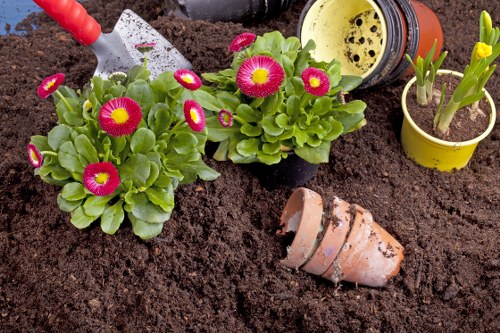Grass Cutting in Lawn Turf Installation: Achieving a Lush and Healthy Lawn

Installing a new lawn turf is an exciting endeavor that transforms any outdoor space into a vibrant, green oasis. However, the installation process requires meticulous planning and execution to ensure the grass establishes properly and thrives. One crucial aspect of lawn turf installation is grass cutting. Proper grass cutting not only promotes healthy growth but also enhances the overall appearance of your lawn.
Grass cutting during the turf installation phase involves several strategic practices that lay the foundation for a resilient and aesthetically pleasing lawn. From selecting the right turf variety to executing precise cutting techniques, each step plays a significant role in the success of your lawn project.
In this comprehensive guide, we'll explore the essential elements of grass cutting in lawn turf installation, offering expert tips and best practices to help you achieve a lush, healthy lawn that stands the test of time.

Choosing the Right Turf for Your Lawn
The journey to a beautiful lawn begins with selecting the appropriate turf variety. Different grass types offer varying levels of durability, appearance, and maintenance requirements.
Consider factors such as climate, soil type, and sun exposure when choosing your turf. For instance, Bermuda grass thrives in warm climates and full sun, making it an excellent choice for southern regions, while Fescue is more suitable for cooler climates and can tolerate partial shade.
Consulting with a local lawn care expert can provide valuable insights into the best grass type for your specific environment, ensuring optimal growth and resilience.

Preparing the Soil for Turf Installation
Proper soil preparation is fundamental to successful turf installation. Healthy soil provides the necessary nutrients and support for grass roots to establish firmly.
Begin by clearing the area of debris, rocks, and existing vegetation. This ensures an even surface and reduces competition for resources. Next, test the soil's pH level and adjust it as needed to create an optimal environment for grass growth.
Improving soil structure through aeration and the incorporation of organic matter can enhance drainage and nutrient retention, fostering a robust lawn.

Precision in Grass Cutting During Installation
Once the soil is prepared, the next step involves precise grass cutting to fit the installation layout. Accurate cutting ensures seamless integration of turf pieces, preventing gaps and overlaps that can lead to weak spots in your lawn.
Use sharp tools or professional-grade equipment to achieve clean cuts. This minimizes damage to the grass blades and promotes healthier growth as the turf settles into place.
Pay attention to the direction of your cuts, aligning them with the natural growth patterns of the grass. This attention to detail results in a uniform and aesthetically pleasing lawn.

Maintaining Proper Grass Height
After installation, maintaining the correct grass height is crucial for the lawn's health and appearance. Regular mowing encourages strong root development and prevents the grass from becoming too tall and unmanageable.
For newly installed turf, it's recommended to set your mower to a higher setting initially. This allows the grass to acclimate to its new environment without undue stress.
Gradually reduce the mowing height as the grass establishes, ensuring it remains at an optimal level for growth and resilience.

Watering Practices for Newly Installed Turf
Proper watering is integral to the success of your lawn turf installation. Adequate moisture supports root growth and helps the grass establish firmly in its new location.
Water the turf immediately after installation to help it settle and begin the rooting process. For the first few weeks, maintain a consistent watering schedule, keeping the soil moist but not waterlogged.
Adjust your watering practices based on weather conditions and soil moisture levels, ensuring the grass receives the right amount of hydration without promoting disease or fungus growth.

Fertilizing for Optimal Growth
Fertilization provides essential nutrients that support the grass's growth and overall health. During the installation phase, applying a balanced fertilizer can give the new turf a vital boost.
Choose a fertilizer that matches the specific needs of your grass type and soil conditions. Organic fertilizers are a great option for promoting sustainable growth and improving soil health.
Follow a regular fertilization schedule, avoiding over-application, which can lead to nutrient imbalances and potential damage to the grass.

Pest and Weed Management
Protecting your new lawn from pests and weeds is essential for maintaining its health and appearance. Implementing effective pest and weed management strategies can prevent damage and ensure your grass remains lush.
Regularly inspect your lawn for signs of pest activity or weed growth. Early detection allows for timely intervention, minimizing potential harm.
Use environmentally friendly pest control methods and selective herbicides to target unwanted plants without harming your turf.

Regular Grass Cutting for Established Lawns
Once your lawn is established, maintaining it becomes a matter of regular grass cutting and care. Consistent mowing schedules help preserve the lawn's health and beauty.
Set your mower blades to the appropriate height based on your grass type, ensuring you don't cut more than one-third of the grass blade at a time. This practice prevents stress and promotes vigorous growth.
Incorporate grass clippings into your lawn care routine, as they provide natural nutrients that enhance soil fertility and reduce the need for additional fertilizers.

Seasonal Lawn Care Tips
Different seasons bring unique challenges and opportunities for lawn care. Adapting your grass cutting and maintenance practices to seasonal changes ensures year-round lawn health.
In the spring, focus on removing winter debris and preparing your lawn for the growing season. Regular mowing during this period encourages rapid growth and sets the tone for a vibrant summer.
During the summer, adjust your mowing height to accommodate increased heat and potential drought conditions, promoting deeper root systems and resilience against stress.

Using the Right Equipment
Investing in quality lawn care equipment is essential for effective grass cutting and overall lawn maintenance. The right tools make the process more efficient and ensure precise results.
Choose a mower that matches your lawn size and grass type. Options range from manual reel mowers for small, delicate lawns to gas-powered models for larger, tougher terrains.
Regularly maintain your equipment, keeping blades sharp and ensuring all components are in good working condition. Well-maintained tools contribute to healthier grass and a more attractive lawn.

Common Mistakes to Avoid
Avoiding common lawn care mistakes can significantly enhance the health and appearance of your turf. Here are some pitfalls to watch out for:
- Overcutting Grass: Cutting too much at once can stress the grass and hinder its growth.
- Improper Mowing Frequency: Mowing too frequently or infrequently can disrupt the grass's natural growth cycle.
- Neglecting Soil Health: Poor soil conditions can lead to weak roots and susceptible grass.
By being mindful of these common errors, you can implement effective strategies that promote a robust and resilient lawn.

Professional Lawn Care Services
While DIY lawn care is achievable, enlisting professional lawn care services can ensure optimal results, especially during the installation phase.
Professionals bring expertise and specialized equipment that can address complex lawn care needs, from precise grass cutting to comprehensive soil management.
Hiring a reputable lawn care service can save time and effort, allowing you to enjoy a beautiful, well-maintained lawn without the hassle of managing every detail yourself.

Sustainability in Lawn Care
Embracing sustainable lawn care practices benefits both your lawn and the environment. Sustainable methods promote healthy grass growth while minimizing ecological impact.
Implementing practices such as mulching mowers to recycle grass clippings, using organic fertilizers, and conserving water through efficient irrigation systems contribute to a greener, more sustainable lawn.
Adopting eco-friendly lawn care techniques not only enhances the beauty of your turf but also supports environmental stewardship.

Conclusion: Achieving Lawn Perfection
Grass cutting in lawn turf installation is a pivotal component of creating and maintaining a beautiful, healthy lawn. By selecting the right turf, preparing the soil, executing precise cutting techniques, and adhering to regular maintenance practices, you can achieve the lush, green lawn of your dreams.
Remember to adapt your lawn care strategies to your specific environment and grass type, ensuring your efforts yield the best possible results. Whether you choose to manage your lawn care independently or partner with professional services, dedication and informed practices are key to lawn perfection.
Contact us today to learn more about our expert lawn care services and start your journey towards a stunning, vibrant lawn that enhances your outdoor living space.